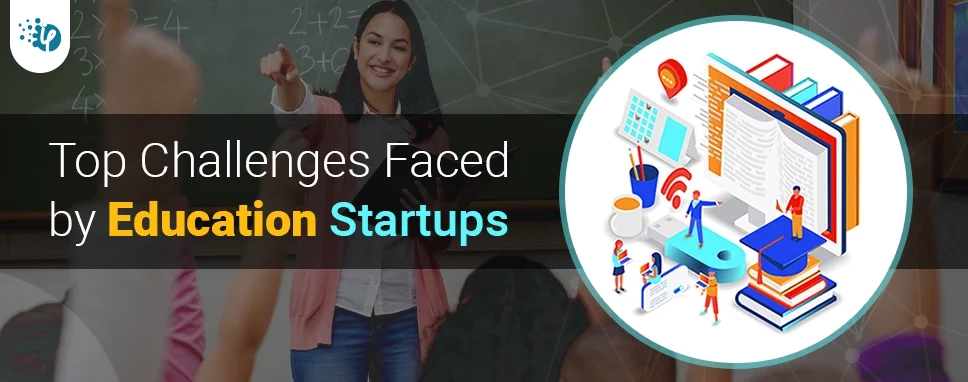ETL vs ELT: Key Differences, Benefits & Use Cases Explained
It's amazing to see how Data teams today are racing ahead - moving from traditional warehouses to cloud-native platforms, lakehouses, and real-time architectures. But in this rush,...
Listening is fun too.
Straighten your back and cherish with coffee - PLAY !

By examining the fact that the number of graduates and post-graduates would increase in numbers annually, the demand for Education sector is not going to be less anymore and would scale-up effectively in the approaching years. The growing interest in e-Learning and teaching excited many people to start their own education businesses. Each day we witness many ed-products enter the market with the hope of success. However, only a few of them get a flying start while others get flipped off with failure. Thus, following right strategies and comprehending development pitfalls is imperative for any Educational Startups.
In this blog, we will figure out some of the major challenges faced by Education Startups and help you get rid of them.
Another method to avoid educational startup failure is to consider your edTech idea as an enhancement rather than a replacement. So, be clear. Focus on the existing LMS's issues and how to overcome them. This will encourage the traditional ecosystem to adopt your technological innovation solution and spread the word. Something that will help target a larger audience without much marketing effort.
*Begin with MVP*A large and sophisticated education app adds to the app development timeline and reduces user acquisition and retention. It will be difficult to win the audience's hearts, especially with new competitors entering the market every minute. In such a case, investing in the notion of Minimum Viable Product maximizes profits and minimizes losses (MVP). That is, incorporating the least functional features and technologies into your edtech mobile app to speed up market entry, reduce development time and costs, and verify your MVP idea.”
- Ethan Howell, Co-Owner of Florida Environmental“One of the big problems with Education Startups is that schools are transitioning to digital learning, but they need specialists (i.e. Quality Assurance Units, Management Consultants) who can help make sure all their learning materials are good enough to replace good-old-fashioned textbooks.”
- Andrew Drow, COO of Cloom“One of the biggest pitfalls many edtech startups face is the fact that the industry is highly resistant to change. From one angle, the industry is in need of innovation as many aims to make the learning and teaching process more comfortable for both students and teachers alike. However, at the same time, there is a significant amount of resistance from administration, local government officials, and even teachers, with many still preferring the traditional classrooms. Moreover, many also remain suspicious of new technology, in regards to user privacy being breached and the data either being sold, used for advertisement distribution, or even used to track users. Besides that, there is also a high amount of competition in the market, and having a lot of players in the Edtech industry often makes finding investors a very tough task.”
- Eden Cheng, Co-Founder of PeopleFinderFree“Lack of investment in the long tail of education: The concentration of existing education startup activity in the short head of the market ignores a significant portion of the market--leaving a gap in online education that can be filled by new startups.
Lack of curriculum design tools: The knowledge, resources, and tools for designing, and constructing a curriculum to support a given learning activity simply do not exist in their present form.
The need to personalize instruction for individual learners: The traditional classroom model limits innovation in education because the teacher is the only person who interacts with learners. The need to provide rich, responsive online teaching materials: These incorporate interactive design elements, audio and video, animations and simulations, humor and graphics to help learners retain information better.
Achieving low cost: Providing quality education at low cost requires both high levels of cooperation among partners (providers of instructional content, web services, software development kits) and low-cost technologies capable of facilitating collaboration across global distances.”
- Lynda Fairly, Co-founder of NumlookerThe pitfalls faced by education startups include slow sales cycles. Due to a slow procurement process which includes approval from multiple departments including IT, finance, provost, and small windows to close deals, breaking into the public education market for higher ed and K -12 can be very challenging. The business models for selling to K-12, Higher Ed, and Professional Development are completely different. Certifications like privacy and security guidelines can also slow down deal flows. In an over-saturated education market and schools having limited funding to pay for resources, many businesses have a challenge deciding who paying customers are educational institutions (B2B) or students (B2C). Many Education Startups must provide free or freemium models which oftentimes do not convert to paid licenses.”
- Kimberly Gray from Uvii“One of the many pitfalls facing education startups is the sheer number of businesses seeking these lucrative contracts. School principals, making most of the buying decisions for a school, get hundreds of emails a day on top of their daily responsibilities. They would rather work with a company they are familiar with than to work with someone new. Principals do not have the time to research new businesses but they are willing to take a risk when cost options are lower than the norm. Many startups will work at a loss to get references that lead to larger contracts.”
- David Hagerman from Schoolscienceassemblies.comUnlike other industries, education sector growth is glacial. In fact, most organizations achieve major growth after 5-10 years, which is uninspired. This bothers entrepreneurs and investors who want a bigger part of the learning app development industry faster. Or, better put, the entrepreneurs and investors who enter the market quickly lose hope and think the situation is hopeless.
*Bad Market Research*There is no doubt that education offers many unique opportunities. But not all are ‘must-haves. Some of those ideas are just too fancy to focus on now. In this environment, startups that enter the educational industry without conducting adequate market research and competition analysis struggle to distinguish between ‘must-have' and ‘fancy' software ideas and ultimately fail.”
- Adam Wood, Co-Founder of RevenueGeeksLack of openness and collaboration with instructors is another reason why many education businesses fail. These firms aim to replace instructors and other educational aspects. So they don't talk about their work or ask for input from professors or others. As a result, educational institutions and teachers are reluctant to accept and use these mobile apps (or software), leading to failure.
*Analyze the Market and Rivals*Many education businesses fail due to a lack of knowledge of market demands and competition solutions. The first step to reducing the risk of app failure is to invest time in-app discovery and knowing your target user base's wants and preferences. In other words, you need to know your target audience's concerns, what existing edTech apps offer, and where they fall short. Decide when and how you can succeed in the educational and learning environment. failure.”
- Rameez Usmani, Tech & Security Expert at Code Signing StoreIt might sound ironic, but the education industry shows a high level of resistance to change. The main aim of colleges and other schools is to provide society with innovative leaders, but these institutions find it difficult to embrace change. Most of them have grown comfortable with the book and whiteboard system, and many teachers also view technology as a threat to their jobs. Such challenges make it difficult for these institutions to grow, and they continue using methods that have a questionable impact on the lives of the learners.”
- Harriet Chan, Co-founder and Marketing Director at CocoFinder“One aspect I’ve never seen discussed is around the cycles of buyers. Education buying often happens in the spring. This means we have a limited window to market and sell software to buyers before we find ourselves waiting another year for the budget to be available. Additionally, budgets might be set years in advance so if a new solution is going to be purchased another might need to be displaced. We can begin marketing in the fall, knowing there likely won’t be any budget by the time we get to winter and that buyers won’t transact until spring, which is when we might book revenue but can’t necessarily accrue that revenue until months later according to the contracts. All of this is to say that whenever marketing software to education, we want to target showing it off as quickly as possible because the sales cycle, according to the release date, could take a year or two - and that can be a make or break time for startups that need to show accelerated growth to investors.”
- Charles Edge, CTO of Bootstrappers.mn“I think one of the biggest ones is building a product that you think people want instead of solving a problem of teachers, administrators, students, or parents are directly facing and know they are experiencing. Without this, too often shiny new technology hits the market and doesn't find a good fit or get lasting users because it doesn't solve a problem.
Another one is trying to do too much. The educational system is complicated and has a LOT of users involved in different ways, so it's easy to try to do too much, too quickly, for too many people, especially in the early days, which causes you to do nothing well. This can lead to not finding your niche or having too many customers that aren't happy because you don't have a core thing you do well that you slowly build around based on real feedback.
Lastly, another pitfall is not understanding the different constituents that are involved in your product in some way, as often teachers and/or students might be the user, but the district or administrators, or sometimes parents, are the purchasers of the product, so you have to adapt your message to each user and ensure the experience with each works well.”
- James Bacon, Director of Outreach & Operations at Edficiency“For startups selling into K-12 school districts and higher education institutions, one of the bigger gotchas is a misalignment between startup runway and prospects' budgeting timeframe. Long sales cycles are the enemy of startups' short capital runways. In education, all too frequently startups find that they are able to connect with prospects that have a desire to engage but have budgetary restrictions that limit the ability to fully adopt the solution until the next budget cycle arises. Savvy founders turn that situation into an opportunity to work together on a smaller pilot leading into a larger deal at budget-time, or an opportunity to secure a larger deal now with creative financing terms such as a generously long timeframe before the first payment is due.”
- Phil Leslie, Managing Director at TechNexusIn the age where apps play a significant role, it is not that easy to get a flying start in the business. Thus, understanding the business pitfalls and applying right strategies for Startup is really important. The rising demand of e-Learning and teaching excited many individuals to start their own education businesses. This blog will help them comprehend some of the major pitfalls faced by Education Startups and ways to get rid of them.

It's amazing to see how Data teams today are racing ahead - moving from traditional warehouses to cloud-native platforms, lakehouses, and real-time architectures. But in this rush,...

Think about the last time CTOs spent most of their time fixing old systems. Updates were slow, servers were expensive, and adding new features took time. Now, things have changed....

Remember our last Power BI forecasting guide? It uncovered what really blocks accuracy. Now it's time to take the next step. Knowing Power BI challenges is just the start - mastering...